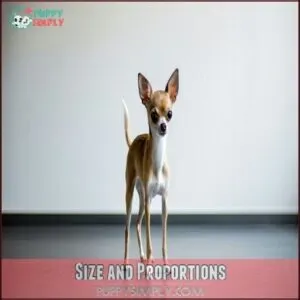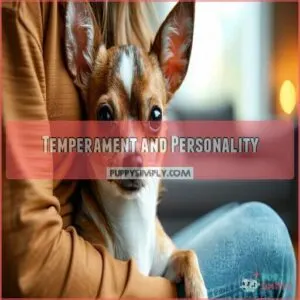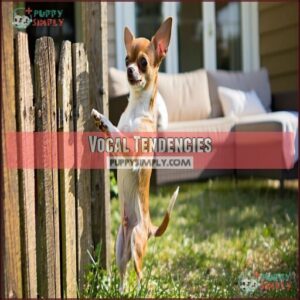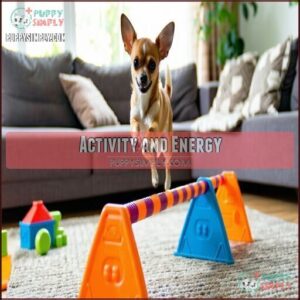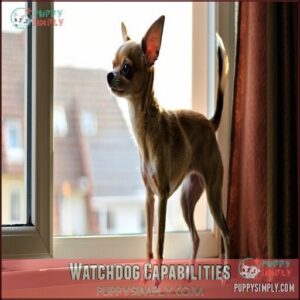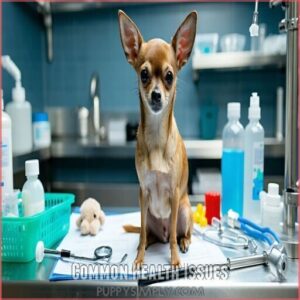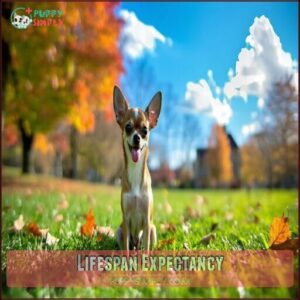This site is supported by our readers. We may earn a commission, at no cost to you, if you purchase through links.
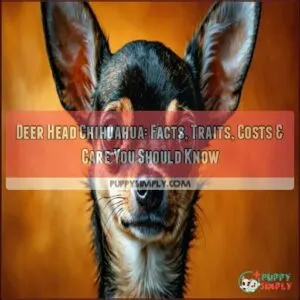 A Deer Head Chihuahua is a distinct type of Chihuahua named for its elegant, deer-like facial structure—longer snout and broader forehead compared to the Apple Head variety.
A Deer Head Chihuahua is a distinct type of Chihuahua named for its elegant, deer-like facial structure—longer snout and broader forehead compared to the Apple Head variety.
These tiny dogs are energetic, loyal, and often fearless, despite their small size.
They usually weigh 7–10 pounds, have varied coat types, and are great for apartment living if you don’t mind their occasional vocal tendencies.
While affectionate, they can be a little headstrong, making training a bit of a challenge.
Health-wise, they’re generally hardy but prone to dental issues.
Curious if they’ll fit your lifestyle? Stick around for more practical tips and insights.
Table Of Contents
- Deer Head Chihuahua Origins
- Physical Traits
- Temperament and Personality
- Vocal Tendencies
- Intelligence and Training
- Activity and Energy
- Suitability for Apartment Living
- Watchdog Capabilities
- Health and Longevity
- Ownership Costs
- Frequently Asked Questions (FAQs)
- Is my Chihuahua an apple head or deer head?
- How much does a deer head Chihuahua puppy cost?
- How much should a deer head Chihuahua weight?
- What is a deer head Chihuahua?
- What are the personality issues with deer head Chihuahuas?
- What is the difference between a deerhead and apple head Chihuahua?
- Why are deer head Chihuahuas not recognized by AKC?
- How much do deer head chihuahuas cost to feed?
- Do deer head chihuahuas get along with cats?
- What age should you start socializing deer head chihuahuas?
- Conclusion
Deer Head Chihuahua Origins
The Deer Head Chihuahua traces its roots back to the ancient Techichi dogs kept by the Toltecs in Mexico, making them part of a rich and fascinating history.
Though not officially recognized by the AKC today, they’re believed to be the original Chihuahua type before the apple head variety gained popularity.
Ancient Ancestry
Your Deer Head Chihuahua carries a rich past rooted in Mexican origins, tracing back to Techichi dogs of ancient Toltec history.
These ancient breeds weren’t just pets—they played spiritual roles in guiding souls.
By the time of the Aztecs, this ancient breed evolved further into the Chihuahua we’re familiar with today.
Here are four fascinating facts about their origins:
- Techichi dogs flourished in Toltec culture, dating as early as 900 AD.
- Revered as spiritual guardians.
- Smaller than modern Chihuahuas.
- Later refined by the Aztecs into adaptable Mexican breeds.
Breed Recognition
Despite their charm, deer head Chihuahuas aren’t recognized by the AKC Standards due to their head shape not meeting Chihuahua breed classification.
These pups are pure Chihuahua breeds and can still register through the AKC registration process for pedigree verification. However, they can’t join traditional kennel clubs shows.
Understanding their long hair genetics is essential for proper care and grooming.
Physical Traits
Deer Head Chihuahuas are known for their unique features, including a sloped forehead, longer muzzle, and larger ears.
With their sloped foreheads, long muzzles, and big ears, Deer Head Chihuahuas bring elegance and charm to any home.
Their compact size and wide range of coat types make them both distinctive and versatile.
Size and Proportions
In regards to chihuahua size, a deer head chihuahua stands out with its elegant build and graceful features.
With a height of 8 to 12 inches, it’s slightly taller than other small dog breeds, thanks to its longer legs and slender neck.
Weighing just 3 to 6 pounds, this compact pup is still lap-friendly despite its larger proportions.
The distinctive deer head characteristics, including its slender neck size, balanced leg proportions, and unique head shape, make it a favorite.
A deer head chihuahua growth chart highlights their perfect blend of stature and style.
To guarantee the health and well-being of your deer head chihuahua, it’s vital to understand their proper care needs.
Coat Varieties
In the case of coat length and texture, Deer Head Chihuahuas offer you options.
A short coat deer head Chihuahua boasts low maintenance and smooth fur, perfect for simplicity lovers.
The long hair deer headed Chihuahua, however, flaunts flowing locks that need weekly brushing.
Both exhibit charming color patterns like brown, fawn, or black.
Shedding issues are moderate, and their grooming needs? Minimal—monthly baths and occasional brushing keep them picture-perfect!
Temperament and Personality
Deer Head Chihuahuas are loyal, feisty, and often bond deeply with one person. While they’re affectionate with their families, their assertive nature means they need proper socialization.
Affection Levels
Those soulful eyes and large ears aren’t just cute—they’re part of the Deer Head Chihuahua’s affectionate charm.
Known for their strong loyal bonds and social attachment, these little sidekicks thrive on personal attention.
They’ll often form heartfelt connections by choosing one person as their absolute favorite and sticking by their side through everything.
While their emotional depth is a huge part of their chihuahua personality, don’t be surprised if their affection needs make them a little clingy—it’s simply their way of showing love!
Interaction With Children and Animals
It’s no secret that chihuahuas can be sassy, and the deer head variety is no different.
These dogs are delicate, making them better suited for older kids who understand gentle play. For more details, review this Deer Head Chihuahua guide.
Proper dog socialization is key to harmonious family dynamics, especially around strangers or new pets.
- Kid Safety: These pups are fragile, requiring supervision with children.
- Pet Compatibility: Calm animals mesh best.
- Chihuahua Temperament: Early socialization prevents animal aggression.
Vocal Tendencies
Deer Head Chihuahuas might be small, but their vocal cords pack a punch! Their barking frequency often surprises new owners, as these tiny dogs have vocalization types ranging from soft whines to full-on yelps that demand attention.
Their volume levels vary based on Chihuahua temperament and dog personalities—some are constant chatterboxes, while others only bark when they feel it’s necessary. These vocal tendencies are deeply tied to communication styles, often expressing excitement, anxiety, or boredom.
Training tips like positive reinforcement can help curb excessive barking. Understanding their dog behavior is key; once you identify why they’re barking, it’s easier to manage.
With patience and consistent training, your Deer Head Chihuahua’s unique communication style can be both endearing and manageable, enhancing your bond with your furry friend, and helping you navigate their vocalization types and barking frequency in a more effective way.
Intelligence and Training
In the context of trainability, your Deer Head Chihuahua is smart but stubborn. Don’t let their small size fool you—they’ve mastered selective listening!
Small in size but big in personality, Deer Head Chihuahuas are clever companions with a knack for selective listening and spirited charm.
Their learning speed depends on keeping things engaging and positive. Think of it as training a toddler with a flair for drama—they know what they want and when they want it.
For obedience training, aim for short, fun sessions (5-10 minutes). Overloading them leads to boredom, and trust me, these little ones won’t hesitate to tune you out. Positive reinforcement is key—treats and plenty of praise work wonders.
Socialization needs are high, so start early. Introduce them to various people, pets, and environments to temper their feisty Chihuahua temperament.
Consistency and patience are essential. With the right approach, their problem-solving abilities will shine, and training can become a rewarding experience.
Activity and Energy
Don’t let their small size fool you—your energetic Deer Head Chihuahua could rival the Energizer Bunny. These lively pups have incredible energy levels and a zest for life that surprises many first-time owners.
With just 15 to 30 minutes of daily exercise, like short walks or playful sprints, your furry companion will be ready to showcase their playful dog behavior.
But it doesn’t stop there. Keep them mentally sharp and active with fun indoor activities that cater to their high energy needs.
Here are five ways to keep them happy:
- Interactive games, like indoor fetch.
- Puzzle toys to challenge their Chihuahua training skills.
- A simple hide-and-seek treat hunt.
- Structured play with other small dogs.
- A mini obstacle course in your living room.
Remember, fulfilling their playtime needs improves Chihuahua care and makes for a calmer, happier pup. Understanding high energy breeds is essential to provide the right activities for your Deer Head Chihuahua.
Suitability for Apartment Living
A Deer Head Chihuahua’s compact size and adaptable nature make it perfect for apartment living.
These small dogs thrive in limited spaces, needing only moderate exercise like short walks or indoor playtime. Consider other breeds for apartment living as well.
With minimal grooming and low maintenance, they’re ideal for busy city dwellers. Their friendly, adaptable temperament guarantees they settle into urban routines easily.
Simple setups—like a cozy bed and toy corner—keep them content. Plus, they’re quick learners, even mastering indoor pee pads, making apartment life comfortable for everyone involved, which is a key aspect of their adaptable nature.
Watchdog Capabilities
With their bold personality and sharp awareness, Deer Head Chihuahuas make surprisingly effective watchdogs.
Despite their small size, their alertness and sharp ears allow them to catch sounds and movements others might miss.
These little dogs take their role seriously, always ready to let out a bark if something seems off.
Their barking tendencies can be frequent, but it’s driven by their naturally protective instincts.
This breed’s territoriality often kicks in when strangers approach, showcasing a strong sense of stranger sensitivity.
Whether it’s someone at the door or an unusual noise, a Deer Head Chihuahua will sound the alarm with confidence.
Their petite size combined with their barking and keen dog behavior makes them an ideal option for anyone seeking a small-space pet that doubles as an alert and attentive guardian of the home.
Health and Longevity
You’ll find that Deer Head Chihuahuas are generally healthy, but they’re prone to a few common health issues like dental problems and patellar luxation.
With proper care, their lifespan can range from 12 to 20 years, making them long-lived companions.
Common Health Issues
These tiny watchdogs are tough but prone to Chihuahua health issues. Common Deer Head Chihuahua health problems include patellar luxation (unstable kneecaps) and tracheal collapse, causing coughing or discomfort.
Owners can purchase products for chihuahua health to help mitigate these issues.
Hypoglycemia is another concern, so make certain of regular meals. Dental problems like overcrowding and decay are frequent, needing diligent care.
Watch for eye issues like cataracts. Regular vet visits and attention to dog health problems keep your Deer Head Chihuahua feeling happy and healthy, which is crucial for preventing tracheal collapse.
Lifespan Expectancy
With a deer head Chihuahua life expectancy of 14-20 years, these pups enjoy one of the longest dog lifespans.
Their golden years depend on smart care.
Focus on these factors to extend their lifespan:
- Regular dental care to prevent common tooth issues.
- A healthy diet paired with daily walks for fitness.
- Prompt attention to any health concerns.
- Routine vet visits and vaccinations.
Your effort plays a huge role in their longevity factors and overall Chihuahua lifespan!
Ownership Costs
Owning a Deer Head Chihuahua comes with both initial and ongoing costs that you’ll need to plan for.
From the purchase price to food, grooming, and vet bills, it’s important to budget carefully for this feisty little dog.
Initial and Ongoing Expenses
Owning a Deer Head Chihuahua comes with a mix of charm and Chihuahua-related costs. Expect to spend on their needs from day one.
- Purchase price: Deer Head Chihuahua puppies cost $300-$3,500, varying by lineage and size.
- Monthly food costs: Budget $15-$25 for premium kibble; add toys/accessories to keep their playful side entertained.
- Vet bills: First-year medical expenses, including vaccinations, can run $100-$200 monthly.
Factor in grooming expenses and essentials like beds or collars, and you’ll cover your furry companion’s lifestyle. Understanding the puppy cost factors is essential for preparing a suitable budget for your new pet.
Purebred Verification
To verify a deer head Chihuahua’s purebred status, you’ll need Pedigree Papers or DNA testing since the breed isn’t AKC-recognized.
Ask breeders for registration details and check the Breed Registry to confirm their Certification Process. Beware of breeders cutting corners—genetic health markers matter.
The authenticity of a Chihuahua can be confirmed through official pedigree documents.
Remember, while deer headed Chihuahuas puppies aren’t AKC-standard, their playful personalities and unique deer head characteristics make them stand out. Are deer head Chihuahuas purebred? Not officially!
Frequently Asked Questions (FAQs)
Is my Chihuahua an apple head or deer head?
Look closely: is your Chihuahua’s head round like a doll’s or angled like a fawn’s?
Apple heads have rounded skulls and short muzzles, while deer heads show longer snouts, flatter foreheads, and larger ears.
How much does a deer head Chihuahua puppy cost?
A deer head Chihuahua puppy typically costs between $300 and $1,200, depending on the breeder, puppy lineage, and coat quality.
Always research reputable breeders to guarantee healthy pups and avoid potential scams or unethical practices, ensuring you find a trustworthy source for your new pet, and avoid potential scams.
How much should a deer head Chihuahua weight?
Your Chihuahua’s weight should match its build.
Deer heads typically weigh 7-10 pounds, though smaller ones might weigh less.
Regular exercise and proper diet are key to keeping them healthy—and avoiding chunky pup syndrome!
What is a deer head Chihuahua?
Like a tiny deer in dog form, a deer head Chihuahua features a wedge-shaped head, long neck, larger ears, and a slender muzzle.
They’re energetic, loyal companions, distinct from apple heads due to their unique appearance.
What are the personality issues with deer head Chihuahuas?
They’re loyal but stubborn, often bonding with one person.
Without socialization, they can get feisty, bark excessively, or act confrontational.
Their sassiness and confidence shine, but their small size can trigger "small dog syndrome" behaviors.
What is the difference between a deerhead and apple head Chihuahua?
Imagine comparing two iconic silhouettes: the deer head Chihuahua has a longer muzzle, larger ears, and a sloped forehead.
While the apple head sports a rounder skull, shorter snout, and prominent, bulbous eyes.
Why are deer head Chihuahuas not recognized by AKC?
The AKC doesn’t recognize deer head Chihuahuas because they don’t meet the breed standard, which requires an apple-dome head and a shorter muzzle.
This preference excludes deer heads from official show competitions and recognition.
How much do deer head chihuahuas cost to feed?
Feeding a deer head Chihuahua won’t break the bank.
With their petite size, they eat about¼ to¾ cup of high-quality dog food daily, costing roughly $10–$30 monthly, depending on the brand, which is a reasonable expense.
Do deer head chihuahuas get along with cats?
Yes, they can get along with cats, but it depends on personalities and proper introductions.
Start slow, supervise interactions, and make certain both pets feel secure.
With patience and training, they can become great companions.
What age should you start socializing deer head chihuahuas?
Start socializing your sassy pup at 8 to 12 weeks old.
This is the sweet spot when they’re curious and keen to learn.
Expose them to new people, pets, and experiences for confidence-building.
Conclusion
Did you know Deer Head Chihuahuas can live up to 20 years with proper care.
This feisty breed combines charm, loyalty, and a bold personality in a petite package.
They thrive in apartments, make great watchdogs, and adapt well to your lifestyle if you’re consistent with training.
Watch for dental issues and make certain regular vet visits to keep them healthy.
If you’re patient and attentive, a Deer Head Chihuahua might be your perfect four-legged companion, offering loyalty in a unique way.
- https://dogacademy.org/breeds/deer-head-chihuahua
- https://www.reddit.com/r/dogs/comments/djokk8/discussion_where_do_deerheaded_chihuahuas_come/
- https://www.rover.com/blog/deer-head-chihuahua-vs-apple-head-chihuahua/
- https://www.chihuahua-people.com/threads/deer-head-chihuahua-vs-chipin.61410/
- http://images.akc.org/pdf/breeds/standards/Chihuahua.pdf


